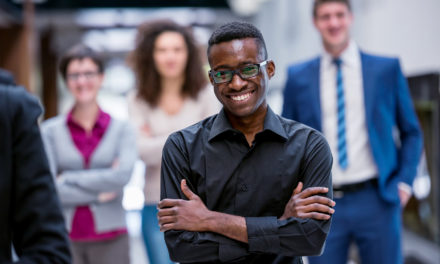by: Candice Dowd Barnes & Todd Scott Parker
The Persistence of Failed Achievement
“Close the achievement gap.” This is a common phrase that educators have heard and used for decades. Yet, the gap remains for so many children, especially minority children and poor children regardless of their racial or ethnic grouping. Research and rhetoric highlights various factors that perpetuate vicious cycles of inequality and inequity that contributes to the growing fissure of achievement among these groups of students. Year after year, we continue to promote strategies and push initiatives to address the problem of inequity. Still, the problem of education inequity persists. Perhaps, we need to change our focus from “closing the gap” to “standing in the gap” with our students.
The gap for many children is a vast and wide valley. There is no bridge to help them cross over into the land of proficiency. They have little to no real access to sufficient resources and opportunities. Teachers, administrators, and sometimes parents, are standing on one side of the bridge beckoning, urging them to just walk across. However, when the student looks down into the valley, their gaze is fixed on a dark, echoing hole to which there appears to be no end and no way out. Just to take the first step for some, will require an incredible amount of courage and support.
For some students, and their families, this is a paralyzing perception of who they are and who they might become. Some students and families see this as the status quo, especially those who suffer generational and institutional inequities. For others they bail out of the learning process altogether. Still others, sit quietly in class hoping the teacher never calls on them to answer a question. What these students need is for teachers, administrators and other caring people, to stand in the gap to offer a meaningful way across the valley divide—a divide that can lead to other academic and social challenges later in life if not addressed early, often, and with intentionality.
So, you might be asking, “If I’m not attempting to implement interventions to close the gap, then what does it look like if I’m standing inthe gap?” Good question. The Model of Influence (MOI) provides four levels to move one from awareness to action (Kohler-Evans & Barnes, 2015). Each level provides a practice to facilitate a shift in one’s thinking and actions toward a greater good. For the purposes of this article, however, the model is used to shift thinking about achievement and education equity.
Shift your Thinking
First, engage in developing a sense of awareness. Be intentional about identifying where the gap or gaps lie for the student. Investigate what specific factors might be an obstacle for the student to achieve. Likewise, identify the gap or obstacle that might be affecting your knowledge and capabilities. Essentially, fill in your own gaps about who the student is, not who, or what, the stereotype threat implies they might be. Refrain from over-generalizing your findings to all groups of students who might share a similar social group.
Second, attend to your personal and professional barriers and beliefs about learning. Acknowledge the narrative created by your personal and professional context and experiences about how students learn and grow. Then, allow for the opportunity for the student to engage in the same approach. It is important that you are open and listening to the perspectives of your student, as much as you want the student to be open and accepting of your thoughts, values, beliefs, and perspectives.
Third, explore the value and benefit of your investing in student’s success. This is essential for them and you. There is the old adage that you can learn as much from your students as they can learn from you. In many ways, that is true. Help your students experience the value of achievement and progress, no matter how small the measure. Help them celebrate those big and small achievements. For many marginalized students, they just need a few wins to counter the losses. Share your experiences of failing forward and how you recovered. Show them what it looks like for you to stand in the gap with them. Give them real and relevant reasons to invest in a future they prescribe, not one that is prescribed for them.
Finally, take action to create a different context for achievement to grow across the classroom and community. Shift thinking and actions toward the idea of being their guide, their bridge, their catalyst for sustained change. Too often educators become satisfied with just a localized activity of success for some of their students. Recognize the greatness of engaging students is a propensity for global greatness within the classroom and community. Embrace your influence and be a change enterprise–a person engaged in an intentional action to change thinking, attitude, and behavior toward a greater good.
In closing, when you are standing in the gap for students it resonates as a bold and purposeful choice to not just call them, the student, to greatness, but it says that you will help them move the chains towards greatness. Students need to know that you may not be able to close the gap forthem, but that you are willing to stand in the gap withthem. That is the truest representation of a cosmic shift in thinking, and the real work of an educator.
About the Authors:
Candice Dowd Barnes, Ed.D., is an associate professor at the University of Central Arkansas in the department of Elementary, Literacy, and Special Education. She is also the Chief Operations Officer for Parker Education & Development, LLC. She strongly believes in the power of authentic learningexperiences to teach beyond the walls of the classroom into all aspects of life.
Dr. Barnes has an extensive background in early childhood education, curriculum and assessment planning, and educational leadership. She is a dynamic speaker and accomplishedauthor of multiple articles on developing authentic relationships and interactions with individuals of diverse and unique backgrounds and histories, service-learning, and social and emotional development. Dr. Barnes has also presented across the country on various topics related to the concept of change enterprise, relatedness skill development, and social and cultural capital.
She is the co-authored of Civility, Compassion and Courage in Schools Today: Strategies for Implementing in K-12 Classrooms,Success Favors Well-prepared Adults: Developing Routines and Relationships to Improve School Culture.
“Learn to lead with cultural competence and civility.”
As a veteran educator, coach, and CEO of Parker Education & Development, LLC, Mr. Todd Scott Parker distinguishes himself through his ability to deliver dynamic educational coaching and professional development. He is driven to inspire leaders and to develop their human and social capital to be prepared to teach and lead people from diverse backgrounds, cultures, and histories. As an author, poet, and energetic-inspirational speaker, he believes in the power one’s personality can have on influencing others toward success.
Mr. Parker is the co-author of, Success Favors Well-Prepared Teachers: Developing Relationships and Routines to Improve School Culture. He is also the creator of the Personality Package™- a process to identify one’s characteristics and traits to determine how to interact genuinely with others.





